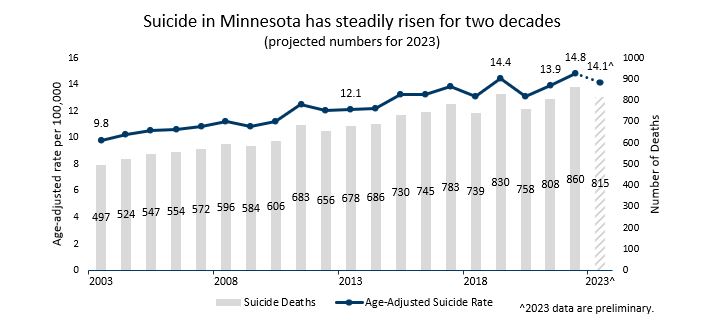News Release
July 31, 2024
Preventable deaths by suicide declined in 2023
SUICIDE IS PREVENTABLE, RECOVERY IS POSSIBLE AND PEOPLE CAN SEEK HELP BY CALLING OR TEXTING 988
In 2023, 815 Minnesotans died from suicide, down from the historically high number of 860 in 2022, according to preliminary data. The suicide rate fell from 14.8 per 100,000 in 2022 to 14.1 per 100,000 in 2023.
The preliminary 2023 data is a positive drop below the previous highest age-adjusted rate of 14.4 in 2019, according to a newly released data brief. Though, health officials caution that achieving a longer-term downward trend will require continued commitment to suicide prevention work. Deaths by suicide in Minnesota have been trending up for the past 20 years with some slight fluctuations each year, mirroring patterns across the United States. The data brief is available at Data Brief: Suicide Up in 2022, Down in 2023 (PDF).

“Though it’s positive to see fewer deaths by suicide, even one is too many. We want Minnesotans to know that suicide is preventable, and hope and help is out there,” said Minnesota Commissioner of Health Dr. Brooke Cunningham. “We must continue our work to promote resources like 988 as well as implement our state suicide prevention plan, which takes a comprehensive public health approach that supports connectedness, belonging and protections from lethal means.”
A suicide death can have profound impact on families and communities. When a person dies by suicide, their surviving family, friends, coworkers, neighbors and community members may feel a sense of shock and prolonged grief as well as experience depression, anxiety or thoughts of suicide themselves. Minnesota’s suicide prevention efforts are based on the evidence that suicides are preventable, mental illness is treatable and recovery is possible.
The Minnesota Department of Health (MDH) 2023-2027 Minnesota State Suicide Prevention Plan calls for a comprehensive approach including improving infrastructure, increasing collaboration and building capacity for local communities to implement strategies in prevention, early intervention, crisis intervention and support after a death by suicide. The plan supports suicide prevention efforts such as the 988 Suicide and Crisis Lifeline, suicide prevention trainings (PDF) in communities and the Zero Suicide initiative, which is a framework to improve the suicide and self-harm care within health care and behavioral health clinics and organizations.
Firearms are often involved in suicides in Minnesota, making up the largest percentage of suicide deaths (47%) in 2023. Historically, white males account for about 80% of the suicide deaths by firearm in Minnesota, and men in general account for about 80% of all suicides in Minnesota. However, women and girls have higher rates of non-fatal suicide attempts. These patterns are likely related to the lethality of firearm injuries compared to other injuries.
Efforts to reduce suicide deaths by firearms include Counseling on Access to Lethal Means (CALM) training. This training promotes strategies for removing or reducing access to the methods people use. Gun locks are one strategy for safely storing a firearm and reducing access to lethal means for someone having suicidal thoughts. The Minnesota Department of Public Safety (DPS) is working with many partners across the state to promote gun locks. Learn more on the DPS Safe and Secure Minnesota webpage. Also see the MDH Preventing Injury and Deaths from Firearms webpage.
Minnesota’s “red flag” law—the Extreme Risk Protection Order Law—took effect Jan. 1. The law allows for people to request an order from the court to temporarily prevent someone from purchasing or possessing a firearm during a period of crisis when they are at risk of harming themselves or someone else.
The 988 Suicide and Crisis Lifeline (988 Lifeline) marked its two-year anniversary in July. In 2023, there were 73,738 contacts (calls, texts and chats) from Minnesotans to the 988 Lifeline, a 43% increase from 2022. 988 Lifeline counselors supported people seeking help to develop over 11,000 safety plans. Safety plans assist people in increasing their personal safety by identifying coping strategies to manage emotional distress. 988 Lifeline counselors also made over 6,000 referrals to mental health or related services. Learn more at the 988 Lifeline Data webpage.
MDH is supporting implementation of new suicide prevention efforts around the state. For example, Carlton County and Canvas Health have been awarded the Regional Suicide Prevention Coordination Grants through MDH to support regional comprehensive suicide preventions efforts that serve all 87 counties and Tribal lands in Minnesota. MDH also funds comprehensive suicide prevention grantees to build community coalitions to develop and implement a data-driven plan. Go to the MDH suicide prevention page for additional information and prevention resources.
If you need immediate emotional or mental health support, or are worried about someone else, please call or text 988 or visit the 988 Suicide & Crisis Lifeline - Call. Text. Chat. (988lifeline.org) to connect online with a trained counselor.
-MDH-
Media inquiries:
Scott Smith
MDH Communications
651-503-1440
scott.smith@state.mn.us